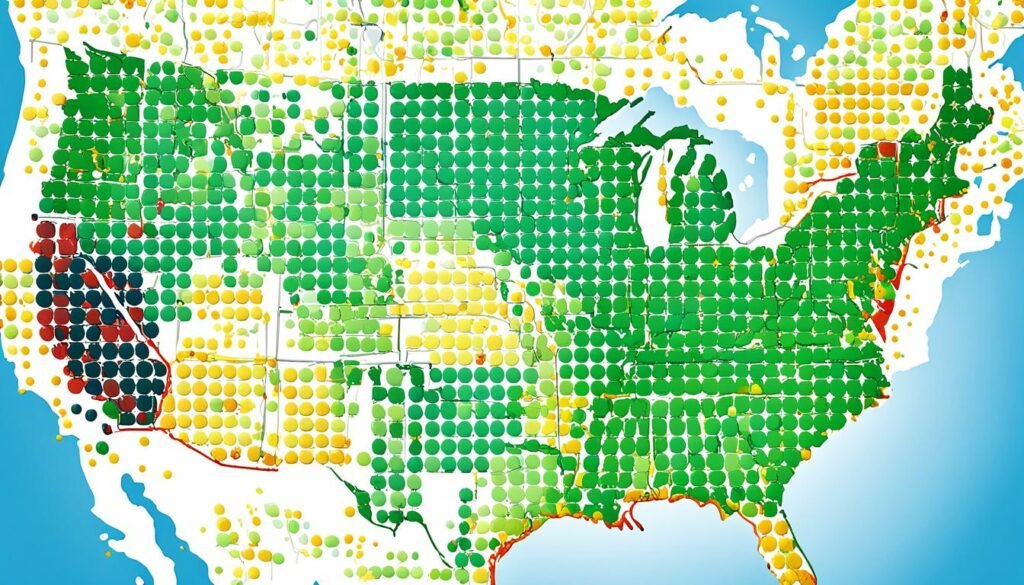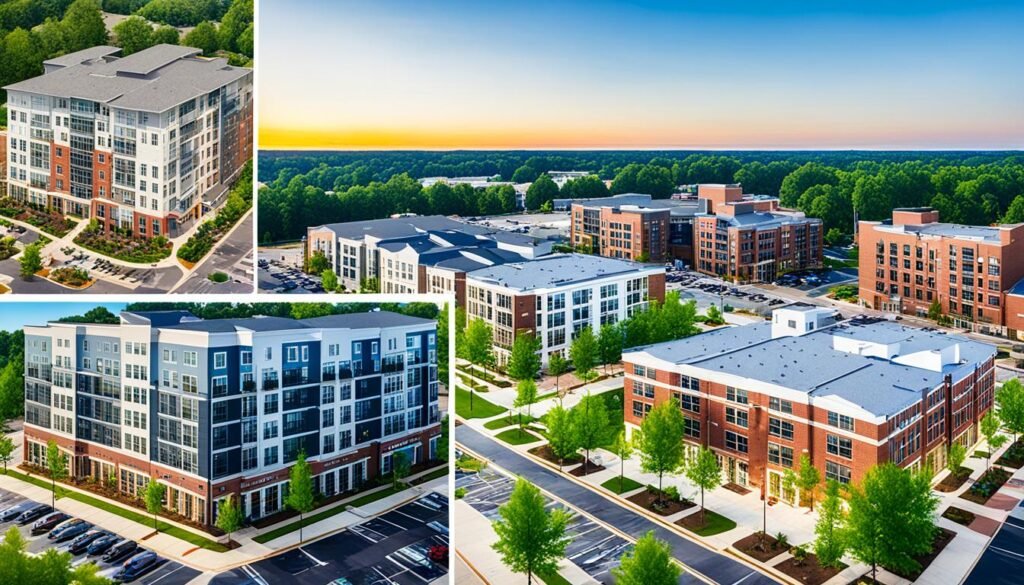Discovering the best cities for multifamily investing is pivotal in today’s dynamic real estate landscape. With particular locales offering more advantageous investment climates, discerning investors are keen on pinpointing those top locations for multifamily investments. A shining example is Jersey City in New Jersey, which has emerged as the leading contender for apartment investment prospects in the coming year1. This trend marks a shift from New York City’s Brooklyn borough, which dominated rankings in the current year1.
Moreover, the allure of these lucrative markets for multifamily properties is underscored by robust metrics such as New York City’s 2.1% year-over-year rent growth1 and the substantial pipeline of over 61,000 apartment units currently under construction, the most of any U.S. metro area1.
Key Takeaways
- Jersey City shines as the top pick for 2024 multifamily investments1.
- Current market leader Brooklyn remains a prime choice with a 53% buy recommendation1.
- New York’s robust rental growth and construction boom signal a healthy market1.
- Cities like Madison and Columbus are earning a strong buy-in from investors1.
- Investigating markets with high occupancy rates and rental demand is key for investing success.
- Emerging patterns point to a diversification of investment hotspots beyond traditional markets.
Key Factors Influencing Multifamily Investment Success
Unlocking the full potential of multifamily investment hinges on a complex interplay of market dynamics and growth indicators. Knowledgeable investors recognize that both macroeconomic factors and specific property attributes can dramatically impact the performance of their real estate portfolios.
Affordability and Potential Cash Flow Opportunities in the Market
To assess the viability of an investment, savvy investors examine potential cash flow opportunities, evaluating the affordability within specific markets. Areas that demonstrate a favorable balance between purchase price and rental income can suggest a promising terrain for establishing a sturdy cash flow baseline.
Population and Job Growth as Indicators of Sustained Demand
Demographic and economic shifts play a pivotal role in shaping the real estate landscape. Cities riding the crest of population and job growth often signal sustained demand for housing, foreshadowing a long-term boon for multifamily properties.
Beneficial Tax Structures and Landlord-Friendly Legislation
Beneficial tax structures and policies that favor landlords can also greatly enhance investment returns. These legal frameworks can be instrumental in reducing operational costs and minimizing risk, thereby attracting investment into burgeoning markets.
High Occupancy Rates: A Sign of a Healthy Rental Market
High occupancy rates serve as a testament to a healthy rental market, often reflecting the fundamental strength of a given location. Investors prioritize regions with a proven track record of keeping multifamily units filled, as this represents both stability and profitability.
Appreciation Rate Projections: Balancing Cash Flow and Equity Growth
Finally, appreciation rate projections are a critical component in an investor’s strategy, allowing for a balanced approach between immediate cash flow and potential equity growth. Markets that offer projections of steady appreciation draw attention from investors looking to compound their wealth over time.
Amidst a shifting financial landscape, certain cities have demonstrated resilience, particularly in multifamily cap rates which have seen a distinct variation. Seattle and Los Angeles report a consistent rate of 4.60%, while Chicago presents a higher figure at 6.50%2. These numbers, influenced by a myriad of factors such as property location, condition, and external economic conditions, have experienced a noteworthy change since Q2 2022, where cities like Los Angeles, San Francisco, and Chicago saw cap rate increases by 0.70%, 0.70%, and 0.90% respectively2.
Understanding cap rates is critical, as they can be swayed by shifting interest rates – a fact exemplified by the recent 0.8% increase nationally between Q2 2022 and Q3 2023 due to interest rate hikes2. Moreover, the intricate relationship between GDP, unemployment rates, and cap rates must not be overlooked, as lower GDP and higher unemployment have historically led to higher cap rates, marking an uptick in investment risk2.
| City | Cap Rate | Change Since Q2 2022 |
|---|---|---|
| Los Angeles | 4.60% | 0.70% |
| San Francisco | 4.20% | 0.70% |
| New York | 4.90% | 0.70% |
| Chicago | 6.50% | 0.90% |
| Seattle | 4.60% | 0.70% |
Mapping Out the Best Cities for Multifamily Investing
When identifying the best cities for multifamily investing, investors seek out markets that promise demographic and structural growth. Such growth is often driven by millennials and a burgeoning middle-income renter demographic, pinpointing prime locations for multifamily developments. Effective asset management and investment strategies, honed over decades, play a crucial role in capturing this segment’s durable cash flow.

Key real estate acquisitions from 2021 to 2022 underscore the strategic targeting of areas poised for expansion. The notable uptick in acquired square footage, with figures reaching 7,399 sq m | 79,649 sq ft in August 2022 and a significant 38,335 sq m | 412,635 sq ft in February 2021, highlight a robust investment focus within the multifamily asset class3. This data aligns with the investment community’s shift towards tapping middle-income markets for reliable returns, rather than exclusively upper-income segments3.
The strategy of mapping out the best locations is not solely about square footage or timing; it’s about recognizing the profound impact of demographic shifts. Millennials, many of whom prefer the flexibility of renting over the commitments of homeownership, are creating sustainable demand in certain urban regions. To capitalize on this trend, savvy investors are homing in on prime locations that promise a blend of lifestyle appeal and affordability—key ingredients for a thriving multifamily market.
| Investment Period | Square Footage | Demographic Focus |
|---|---|---|
| Aug 2022 | 79,649 sq ft | Millennials & Middle-Income |
| May – Sep 2021 | 258,960 sq ft – 412,635 sq ft | Millennials & Middle-Income |
| Feb 2021 | 331,767 sq ft | Millennials & Middle-Income |
Ultimately, the success of multifamily investments hinges on the investor’s ability to discern areas with heightened demand. These prime locations for multifamily developments are typified by an investment ethos that champions not just quantity, but strategic quality—prioritizing areas where the population’s growth is both dynamic and sustainable3.
Southern Charm & Tech Driven Markets: Atlanta and Austin in Focus
The landscape of multifamily investing continues to evolve, with certain geographies emerging as particularly opportune given their economic dynamics and demographic trends. Notably, Atlanta and Austin stand out as vibrant cities beckoning investors with their unique allure.
Atlanta: A Hub for Diverse Markets and Steady Growth in the South
Atlanta’s multifamily investing prospects are enhanced by its recognition as one of the best places in the Eastern United States for rental properties4. This city, emblematic of steady growth in the South, is a mosaic of diverse markets catering to professionals, families, and students alike. The robust rental demand parallels its economic vigor, making multifamily investing in Atlanta a strategy with sustained traction.

Austin: The Silicon Hills of Texas Attracting Tech Pioneers
Meanwhile, Austin’s claim to fame in the real estate realm is its dynamic, tech-driven market which has been magnetizing an influx of tech giants and startups – effectively earning it the moniker of ‘Silicon Hills’. Its median rent approximates at $1750 per month, reflecting a tech-driven market in Austin that’s not only burgeoning but also boasts a growing population and low unemployment rates4. As the city’s skyline is reshaped by modern developments, the investment appeal of multifamily properties amplifies, underscored by the region’s innovative spirit and economic resilience.
Investing in these urbane Southern and tech-centric Texan havens can present a kaleidoscope of opportunities, leveraging the regional growth and diverse tenant pools. Furthermore, such investments may yield lucrative returns as these cities continue to chart paths of expansion and prosperity.
Emerging Hotspots: Birmingham and Columbus’ Multifamily Landscape

As the multifamily real estate market continues its transformation, certain regions are distinguishing themselves as emerging hotspots for multifamily investing. Birmingham and Columbus stand out with their unique combination of economic resilience, growth potential, and tenant demand. These cities signify a paradigm shift—a move towards secondary markets that may offer higher yields and substantial scalability for savvy investors. For those in search of opportunities in evolving markets, Birmingham’s multifamily landscape offers a rich ground for exploration.
The multifamily opportunities in Columbus have also been bolstered by the city’s economic diversification and expansion. Notably, statistics suggest a trend where a significant number of Gen Zers and young millennials are opting to continue renting instead of buying due to high mortgage rates and limited inventory5. This demographic pivot strengthens the demand for rental housing, presenting an optimistic prospect for future occupancy rates and rental income stability.
As we analyze these emerging hotspots, it’s crucial to note the shifting dynamics in real estate preferences. An estimated 16% decrease in existing home sales in 2023 compared to 20225, paralleled by an anticipated 20% fewer sales of newly built homes5, illustrates a broader market trend favoring rental properties. Additionally, builders are predicted to focus more on multifamily rental units in response to market conditions, acknowledging the durability of the sector amidst a volatile economic backdrop5.
The investment appeal of Birmingham and Columbus is further supported by national trends affecting the commercial real estate sector. An immense $49 billion in mortgage loans sought relief in the early weeks of the U.S. COVID-19 outbreak6, indicating disruption but also underscoring the potential for debt restructuring and investment recalibration. This, along with nearly 47% of relief requests coming from hotels6, suggests that multifamily assets may fare better given their essential housing status and potential for sustained revenue generation.
In evaluating the fiscal attractiveness of these cities, Columbus and Birmingham warrant attention for their multifamily landscapes which stand poised for a period of considerable growth and remarkable investment returns. Thus, in marrying demographic trends with economic forecasts, investors are urged to consider the long-term advantages inherent in these two flourishing Southeastern and Midwestern locales.
Conclusion
In conclusion on multifamily investing, it’s crucial for investors to delve into markets that show great promise through a combination of growth indicators and sustained demand. The journey toward real estate prosperity is underscored by examining trends and metrics that signal profitable ventures. As the summary of top cities unveils, the US housing market’s tempering in price acceleration alongside a boost in available inventory heralds a strategic moment for investors7. Especially noteworthy is the single-family rental sphere, where build-to-rent properties have surged to an unprecedented high7. Furthermore, the stability of cap rates at 5.3% in this segment, even amidst rising interest rates, spotlights the resilience and attractiveness of single-family rental investments7.
Within this landscape, Boise, Idaho emerges as a compelling case with a staggering home appreciation of more than 217% over the last decade7. The city’s recent quarterly appreciation rate projects an annual climb over 16%, while the median home price sustains at a competitive level, with a slight year-over-year decrement, signaling a moment for potential market entry7. Properties are selling in relatively swift fashion, and given the sales-to-listings ratio, Boise is undeniably a seller’s haven7. A narratively woven fabric of data portrays Boise as a prime example of the kind of market multitemporal investors seek for both short-term gains and long-term equity buildup.
Anchored on this real-world analysis, the value in carefully selecting your investment destination becomes clear. By pivoting towards locations underscored by an advantageous balance of appreciation rates and stable listing prices, like Boise, investors can align their strategies for a potentially fruitful outcome. For further insights and a detailed examination of the most opportune markets, consider exploring the thorough evaluations of best places to invest in real estate to underpin your investment decisions with data-driven clarity7.
FAQ
What are the key factors that influence multifamily investment success?
How can affordability and potential cash flow opportunities impact multifamily investments?
Why is population and job growth important for multifamily investments?
What role do beneficial tax structures and landlord-friendly legislation play in multifamily investing?
How do high occupancy rates contribute to a healthy rental market?
What is the significance of appreciation rate projections for multifamily investments?
How can I map out the best cities for multifamily investing?
What makes Atlanta and Austin attractive cities for multifamily investing?
What are the emerging hotspots for multifamily investing?
Source Links
- https://www.forbes.com/sites/richardlawson/2023/11/07/heres-the-surprising-top-city-for-2024-apartment-investment/
- https://www.jpmorgan.com/insights/real-estate/commercial-term-lending/cap-rates-explained
- https://www.nuveen.com/global/investment-capabilities/real-estate/us-cities-multifamily
- https://www.baymgmtgroup.com/blog/rental-market-projections-2021/
- https://www.soundmultifamily.com/blog/
- https://freddie80.rssing.com/chan-10836238/all_p7.html
- https://www.noradarealestate.com/blog/best-places-to-invest-in-real-estate/
As a passionate, global-thinking Real Estate Investor I am constantly looking for the best opportunities to invest in Properties. With Aparthotel.io I am building an All-In-One Global Real Estate Platform, where people can analyse, rent or invest in properties. Additionally I help Investors with comparing the best financing options as well as give detailed Consultation on the buying process for Real Estate Investments around the world. I am looking forward to sharing my knowledge on this Website and feel free to reach out to me if you have any questions.
Comments